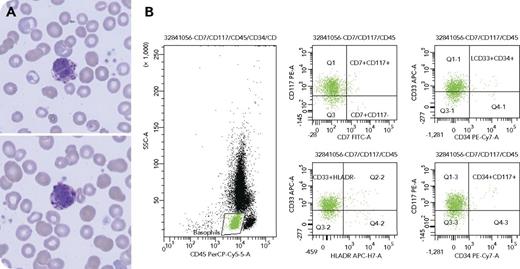A 74-year-old man was admitted following a syncopal episode and was incidentally found to have leukocytosis with basophilia. A peripheral smear evaluation revealed basophils with atypical nuclear lobation and decreased granularity (panel A; modified Wright's stain, original magnification ×100). A bone marrow biopsy revealed a hypercellular, myeloid-predominant marrow with megakaryocyte clustering and dysplasia but no increase in blasts. Flow cytometry of both the blood and marrow revealed an increased population of CD45mod+, atypical-immunophenotype basophils that were dimly positive for CD33 (atypically decreased) and CD117 (atypically increased) and negative for CD34 (panel B). Molecular studies were notable for a JAK2 V617F mutation and negative for BCR-ABL. Next-generation sequencing identified oncogenic variants in IDH2, SRSF2, and ASXL1. Karyotype was normal, as were fluorescence in situ hybridization studies. The patient was ultimately diagnosed with a myelodysplastic/myeloproliferative neoplasm.
This case is an illustrative example of atypical basophilia in myeloid neoplasms. Classically, chronic myeloid leukemia with t(9;22) presents with basophilia; notably, however, it can be seen in other myeloproliferative and myelodysplastic/myeloproliferative neoplasms. Normal basophils have segmented nuclei (often obscured by coarse basophilic granules) and are CD45mod+/CD34−/CD33+/CD117−/CD38++/HLA-DR−/CD64−/CD123++. It has been shown that in myeloid neoplasms, basophils are increased and often have decreased CD38 expression and variable expression of CD34/HLA-DR/CD117/CD64/CD123, which can be easily mistaken for blasts.
A 74-year-old man was admitted following a syncopal episode and was incidentally found to have leukocytosis with basophilia. A peripheral smear evaluation revealed basophils with atypical nuclear lobation and decreased granularity (panel A; modified Wright's stain, original magnification ×100). A bone marrow biopsy revealed a hypercellular, myeloid-predominant marrow with megakaryocyte clustering and dysplasia but no increase in blasts. Flow cytometry of both the blood and marrow revealed an increased population of CD45mod+, atypical-immunophenotype basophils that were dimly positive for CD33 (atypically decreased) and CD117 (atypically increased) and negative for CD34 (panel B). Molecular studies were notable for a JAK2 V617F mutation and negative for BCR-ABL. Next-generation sequencing identified oncogenic variants in IDH2, SRSF2, and ASXL1. Karyotype was normal, as were fluorescence in situ hybridization studies. The patient was ultimately diagnosed with a myelodysplastic/myeloproliferative neoplasm.
This case is an illustrative example of atypical basophilia in myeloid neoplasms. Classically, chronic myeloid leukemia with t(9;22) presents with basophilia; notably, however, it can be seen in other myeloproliferative and myelodysplastic/myeloproliferative neoplasms. Normal basophils have segmented nuclei (often obscured by coarse basophilic granules) and are CD45mod+/CD34−/CD33+/CD117−/CD38++/HLA-DR−/CD64−/CD123++. It has been shown that in myeloid neoplasms, basophils are increased and often have decreased CD38 expression and variable expression of CD34/HLA-DR/CD117/CD64/CD123, which can be easily mistaken for blasts.
For additional images, visit the ASH Image Bank, a reference and teaching tool that is continually updated with new atlas and case study images. For more information, visit http://imagebank.hematology.org.


This feature is available to Subscribers Only
Sign In or Create an Account Close Modal